Yesterday morning I made the 90 minute drive to a remote area of Box Elder County only to have low, bright-white clouds roll in soon after I arrived. There was a tremendous amount of snow on the ground up there so I was in a completely white world. Much of the time I couldn’t even see a horizon because the ground blended into the sky at a boundary that could not be discerned – definitely not the best conditions for bird photography.
So this cooperative adult Red-tailed Hawk with prey was a huge challenge under those conditions.
1/1600, f/7.1, ISO 500, Canon 7D Mark II, Canon EF 500mm f/4L IS II USM + EF 1.4 III Extender, not baited, set up or called in
Here the hawk is perched on the side of a south-facing cliff so there’s little snow there. Notice that the bird has the remains of a rabbit in its talons. The hawk’s crop appeared to be bulging so it wasn’t interested in eating at the moment but it still didn’t want to give up the rabbit, especially to the likes of a…
pesky nearby magpie that we see in the same image cropped differently.
1/8000, f/6.3, ISO 500, Canon 7D Mark II, Canon EF 500mm f/4L IS II USM, not baited, set up or called in
So eventually the hawk took off with the rabbit and I was able to get several reasonably sharp photos just before it flew in front of the cliff face to my left. Here the (un)lucky rabbit’s foot dangling down helps to identify the prey.
1/8000, f/6.3, ISO 500, Canon 7D Mark II, Canon EF 500mm f/4L IS II USM, not baited, set up or called in
Notice how the bird has pulled the rabbit straight up into its body rather than tucking its prey-laden feet under the base of its tail like they usually do during flight when they’re not carrying anything heavy. This must be the most energy-efficient position to carry the large rabbit.
1/4000, f/6.3, ISO 500, Canon 7D Mark II, Canon EF 500mm f/4L IS II USM, not baited, set up or called in
This is the last sharp shot I got before the hawk passed in front of the cliff face and my focus points grabbed onto the nearby rocks.
There’s another parallel story here that I should cover for photographers who wonder about my incredibly high shutter speed when the bird took off. I shoot in aperture priority and with that bright-white background my SS was what I call “hummingbird fast”. But I knew that since it was carrying heavy and unwieldly prey there was a very good chance that the hawk would launch at a low angle and pass in front of the much darker cliff face instead of taking off upwards into the bright sky and if that happened my SS would drop dramatically. I wanted to make sure I at least had a chance for sharp flight shots as it passed in front of the dark cliff face so I left my SS incredibly high when the bird first took off.
Did it work? Well,… yes and no.
You’ll notice that in the last shot above my SS has already dropped by half (1/8000 to 1/4000) as the background begins to become darker. As the bird passed directly in front of the much darker cliff face my SS dropped all the way down to 1/1250 – barely fast enough for a hawk in flight. But in those shots all I have is sharp rocks and a very soft bird because my focus points grabbed onto the nearby cliff.
Next time I hope to have the skill required to keep locked onto the bird in those conditions.
Ron


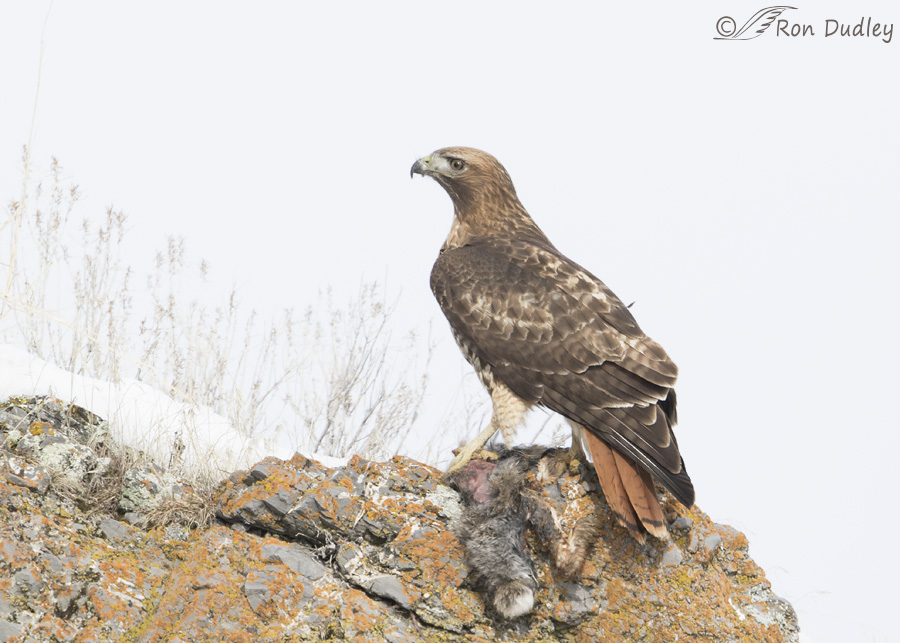
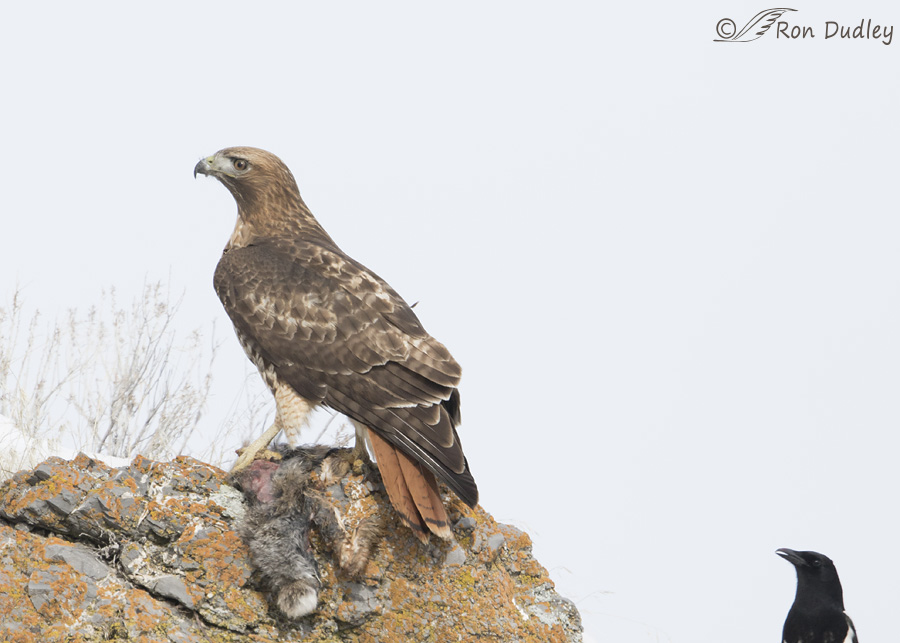
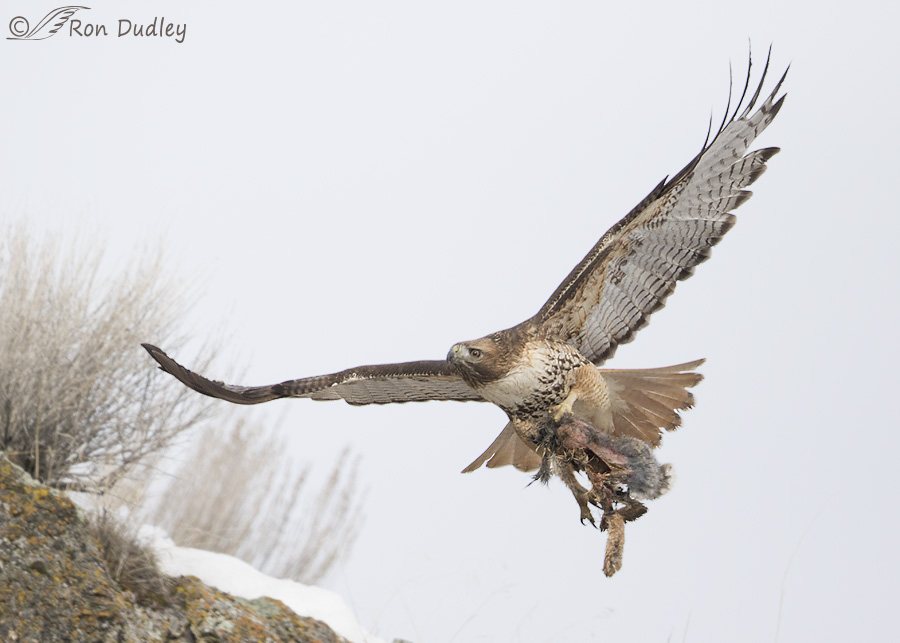
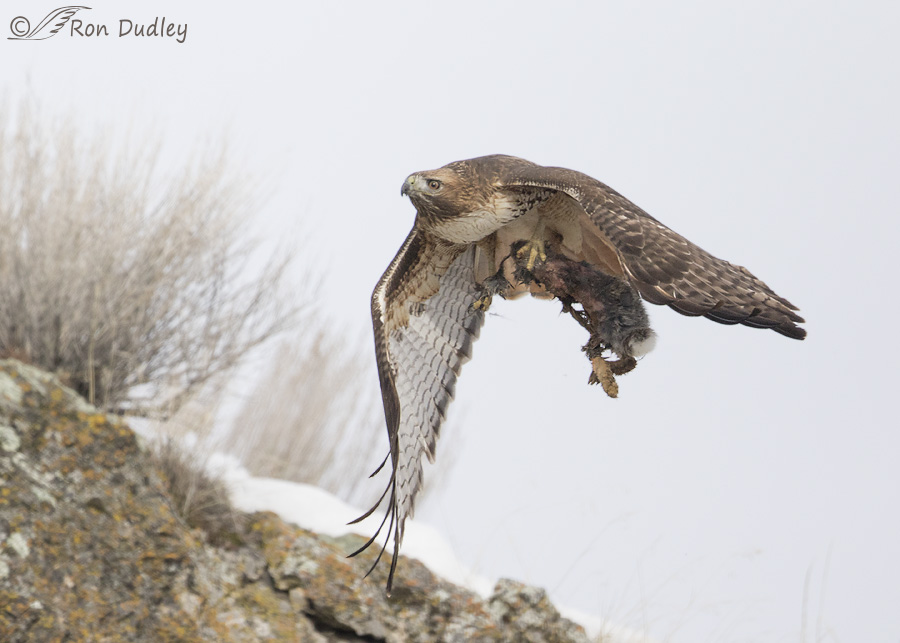
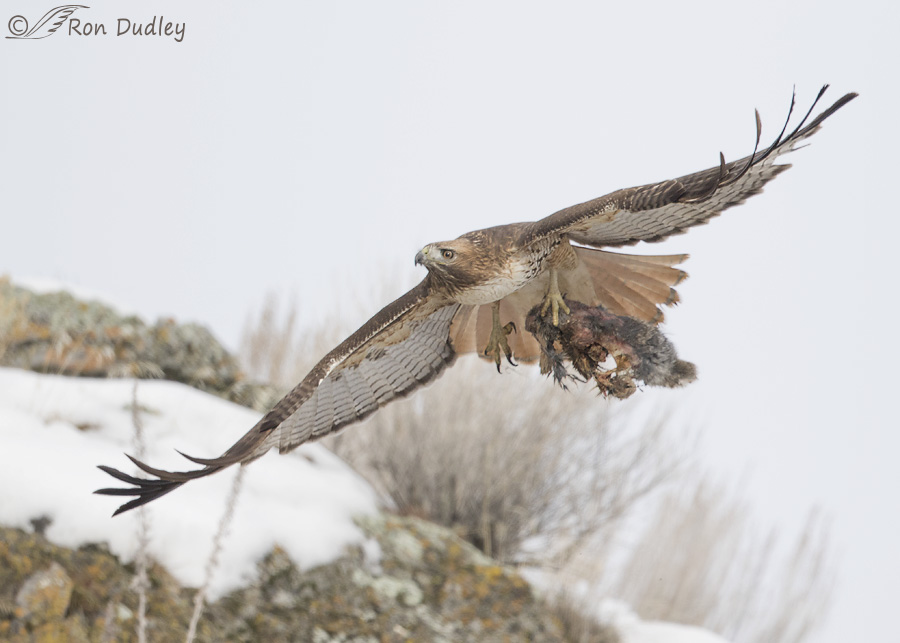
Awesome series Ron!
Charlotte
Awesome series Ro!
Charlote
Real nice series of events. I love the look in her eyes. Very determined!
Thanks, Jean.
Nice sequence of images Ron. I like the tilted head on the RTHA as it takes off. Thanks for the explanation of the shutter speed, it is interesting to see how it changes in the sequence using aperture priority.
Thank you, Ed.
Ron. series and explanation is lovely as usual….nature photography at its best . Love your uncompromising ethical approach towards bird photography.. best anil
“Love your uncompromising ethical approach towards bird photography”
Thanks, Anil. Part of my motivation for that is selfish. I like to be able to sleep at night…
Super capture!!! Physics and anatomy and a gorgeous bird! I’m loving the extreme curve of the leading edge of the wings. And the carrying position makes total sense — like lugging around a stack of books close to your body. (Boy am I glad I caught autocorrect on that sentence! Yes it did!)
I do feel a little sorry for bun bun and his little poofy tail, but a hawk’s gotta eat.
The second shot also strikes me as typical magpie — the annoying little brother pose. Gives me a little giggle.
Marty, maybe someday I ought to post some of the funny things autocorrect has done to me and then invite readers to do the same in their comments. I’m sure it would be a highly entertaining post but almost certainly X-rated…
You had me at Redtail (you knew that), but then…Oh WOW! I just love the whole series for about a dozen different reasons–the magpie with thievery on its mind, the takeoff and flight, that the redtail is eating well and that she is in fine feather, the power of her flight and the intensity of her gaze, how the colors play with each other and just everything! Thank you for beginning my day, once again, with outrageous beauty.
What a wonderful way to begin the day, tackling all its current challenges. Several years ago, back when I was working a real job, I used to carry hawk bells in my pocket for when the challenges of the day/humans got on my last nerve and I was ready to lose it. Just the sound of the bells reminded me that I would soon be in the field, sharing the day with Mariah and that all would soon be well. Your posts are serving the same function these days. You (and Mia) bring a beauty touchstone that helps me get through the day. Thank you!
Maybe we all should get some of those bells, Laura. These days I think most of us could use them! Thank you.
The bells worked for me…but I’m not sure they’d work under these current circumstances. Worth a try, though!
Beautiful shots and a very salient point, in my mind, concerning aperture priority. Many thanks for the photographic tid-bit!
However, I would love to know why I’m having so much trouble with my focus points as you said ” focus points grabbed onto the nearby rocks” seems to be my problem when I’m trying to catch a red-tail fly in front of trees or a bird in shrubs. It is a real pain!
It sure is, Dick – for all of us. BIF shots with close backgrounds are among the most difficult of all to get sharp. It comes with the territory.
Very true, Ron. So far, I’m content with using C1 for perched birds and C2 for flying birds. By the way, I use 9 focus points instead of 5. Some eagle enthusiasts suggested that to me.
But I would trust your vast experience over theirs and mine!
9 active focus points is probably just as good as 5 overall and for the long haul, Den. I stick with 5 all the time for BIF just so I’m as familiar as possible with how it performs.
Beautiful shots, Ron! Looking at the first, I’m once again reminded of why some of my Lakota friends call the Red-tailed “little brother of the eagle”…for their resemblance to the (Golden) eagle….
Thanks, Patty. The Lakota know what they’re talking about…
Hi Ron. Once again great series. Hawks with prey is one of my favorite subjects. I just wish I had more opportunities. I agree with using 5 AF points. I am just not that good to be able to keep a single point on a moving subject. 5 is hard enough. Re the AF case settings, I still don’t understand the various options offered by Canon in their top end cameras, but I do understand the option and benefit of slowing down the speed the camera changes focus with changing backgrounds. It was once recommended to me to use Case 3 and slow down how fast the camera changes focus. Once it’s set with a new body I never change it. I seem to be getting reasonable results, so why change.
Once again, I find your use of Apeture priority interesting. As you know I use manual. Here is my theory. In this case, the light “on” the bird is not changing, only the amount of dark background in the image which is causing the camera to change the exposure. A full stop! 1/2 the light. A full stop in my mind is a bunch especially when considering the highlights. So here, you have the subject in the same light with two different exposures. Why would you want that? Or, do you think it matters? In my mind, one stop can make or break a photo, especially in bright bright light, which obviously you were considering your initial shutter speed and ISO 500. So, in your opinion Ron, is there a better exposure here?
Frank, all I can say is that there’s probably a better way than “my way” for most folks.
I do what seems to work best for me overall, especially since I’m such a creature of habit. I stick to that method through hell and high water until I know it inside and out. That way I don’t make quite so many mistakes.
Nice! Magpies are a pain at times! Thx for the “tech” stuff also. Snow and clouds can be a bugger to deal with at times including white balance!
Thx for the “tech” stuff also. Snow and clouds can be a bugger to deal with at times including white balance! 
Exactly, Judy. With those kinds of backgrounds I sometimes get slightly pink or purple skies that shouldn’t be…
Had you not mentioned the presence of the rabbit in the first shot, I might never have seen it, because it blends so well with the rock. I like the flight shots, and find it interesting that the bird is carrying the large rabbit with just one foot, given how big and heavy the prey appears to be.
I agree, Susan, the rabbit is hard to see on that rock. Cryptic coloration even after death…
Very impressive shots all the same!
I love seeing the sequence of the wings’ leading edge and primary feathers.
Thank you.
As do I, D. Thank you.
Nice series (as usual!), Ron. I always appreciate your photos and narratives. Very educational!
Regarding keeping the bird in focus when it passes in front of the cliff, have you already modified the Canon 7D Mark II focus settings that make the camera “most reluctant” to change the focus to a different subject? And which focus points do you use for this situation?
Thanks!
Den, I’ve played around with that modification but in the end I usually leave those settings at sort of a compromise. I nearly always use the center 5 focus points for birds in flight and that’s what I was using here.
Thanks for the reply, Ron. Can you educate me as to why you use those settings at a compromise, instead of, say, assigning an “uncompromising” set to one of the three custom dial settings? Thanks!
To be honest it’s mostly because I’m a creature of habit. What works best for me is to find a setting that I think works best overall and stick with it through thick and thin. I find that familiarity with how a setting works gives me better results than changing them all the time. Plus I don’t miss shots while changing those settings…
Many shooters would argue with that philosophy but to each his own!
There’s no doubt you’re a much more experienced bird photography than I. I have picked what I think are the best settings for flying birds and assigned them to the C2 location on my dial. So I do have to turn to C2 when photographing birds in flight, but I find that a reasonable method.
But as you say, to each his own!
Thanks for your viewpoint!
That’s exactly what most folks do with the Mark II, Den. And it definitely has its advantages, especially when birds are already flying around you.
But it seems to me that the weak point there is switching to C2 which takes another adjustment and time just before or during the takeoff and those takeoff shots are high on my list of desirable shots. True, I could switch over long before the bird takes off but then I’ve lost the advantage of the “perched setting”.
Tradeoffs, always tradeoffs…